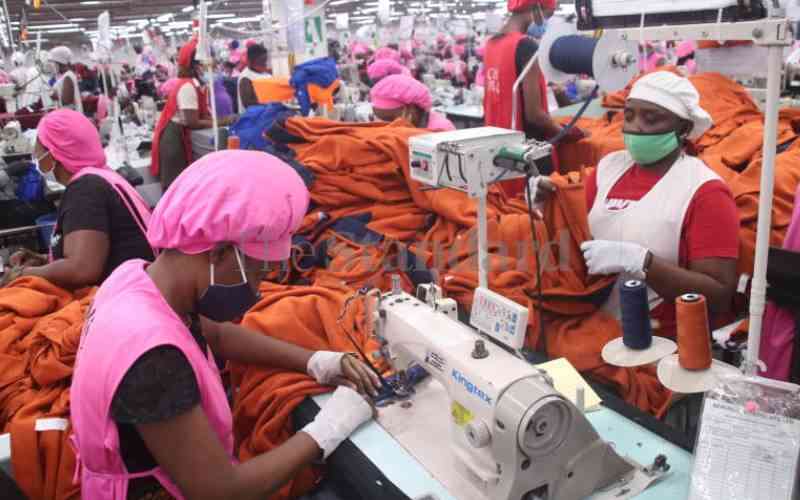
Construction of Likoni Road and Enterprise Road which dissect Nairobi’s Industrial Area has stalled.
The contractor, after digging up the round-about where the two roads intersect, evacuated their construction equipment leaving behind an obnoxious trail of traffic gridlock at the heart of the country’s manufacturing.
It is worth noting that almost every enterprise in the sprawling Industrial Area uses Enterprise Road.
A good number of the industries are then linked to Mombasa Road via Likoni Road. It is from Mombasa Road that cargo is either imported or exported through the Port of Mombasa.
Interfering with the flow of traffic on the two roads is tantamount to ‘economic sabotage’ - interfering with the turn-around time for enterprises around this location.
But who cares? If anything, the construction which started over five years ago is far from being completed.
Regrettably, this ‘economic sabotage’ has not raised an eye-brow. “Really, where in this country does such a thing happen?” wonders the Chairperson of Kenya Association of Manufacturers (KAM) Flora Mutahi.
Ms Mutahi says this only shows the extent of neglect of the Industrial Area. This even as Kenya eyes to be “an industrialised, middle-income country” status by 2030. “Some members of staff have chosen to work in town rather than in Industrial Area,” Mutahi explains.
Industrialised economy
It seems that in its excitement to create a fully industrialised economy teaming with special economic zones (SEZs) and industrial parks, Kenya is fast forgetting her source of industrial prowess - the Industrial Area.
Located in the Southeastern end of Nairobi’s Central Business District, the Industrial Area is as old as the city itself.
With a size of about 9.6km2, Nairobi’s industrial hub was by the time of its inception in 1919 the biggest industrial zone across the region.
It has remained as such for over 100 years that it has been in existence, catapulting Kenya to the pinnacle of industrial competitiveness in the region.
A number of global brands have their homes in the Industrial Area including manufacturer of fast consumer goods Unilever, Proctor and Allan, Isuzu, Pfizer, BAT, Sameer, P&G among others.
Stay informed. Subscribe to our newsletter
Today, the once vibrant industrial sector is now a shadow of former self. It is not only characterised by construction projects abandoned mid-way but most of the public infrastructures are in dire need of a re-touch.
“Now, most godowns are relocating to Baba Dogo, no one wants to put a godown in a place that is not accessible,” reckons a steel manufacturer, who did not want to be named. Feeder railway lines which snaked into every nook and cranny in the sprawling manufacturing district have since been overgrown with grass and shrubs. Almost all the roads are dilapidated, narrow and encroached by gangs of hawkers selling various merchandises.
The pot-holes on the roads are so wide that when it rains, form into small ‘ox-bow lakes.’
Infrastructural neglect point to a scheme as though the old Industrial Area - with its browning, derelict buildings is not part of Kenya’s industrial future. Ms Mutahi feels that more could have been done for an area that contributes a lot to the economy.
She is of the view that such infrastructure as security, sewer lines, lighting in the once economic heart beat of the country are still wanting. “I think it is a disgrace,” she lamented.
Indeed, the degeneration of the Industrial Area has starkly coincided with the stagnation of the country’s manufacturing industry - a critical sector with the potential to absorb hundreds of thousands of unemployed youths.
Already, the manufacturing sector is estimated to employ over 300,000 people. Ms Mutahi estimates that a third of these eke out their living from the Industrial Area.
The World Bank’s 2016 report noted that while Kenya, like most developing countries, has been hit hard by the manner in which globalisation and trade has worked, it has struggled to come up with “intensive network capabilities needed for modern manufacturing.”
Kenya, said the World Bank report, has struggled to “develop deep public-private networks of regulation, facilitation, skills, and infrastructure.” Instead, the country has invested its energy and pumped money in developing such sectors as banking and telecom “where networks are somewhat easier to establish.”
Of course, there have been tentative efforts to revamp the worn-down infrastructure in the Industrial Area with some roads that had been abandoned for over 50 years being tarmacked, according to Ms Mutahi.
A senior official in the State Department for Investment and Industry, who did not want to be quoted as he is not permitted to speak to the media, concedes that the Government’s aggressiveness in pursuing new models of manufacturing might have blinded it from seeing the pathetic condition of the Industrial Area.
He however insists that the enterprises are also to blame for failing to take up new technologies.
He cites the steel, cement and sugar factories which use extremely old technology, some which consume a lot of power and thus increasing their cost of production as some glaring incidences. “Even after the Government zero-rated VAT on raw materials and machinery in the Finance Act of 2014, most of these industries did not take up the offer,” said the official.
He noted that most of the factories in the Industrial Area are using obsolete machines with old motors which are consuming a lot of energy.
For most Kenyan factories, there is a long value-chain which adds to the cost of production. He says with the new model of manufacturing, enterprises do not need warehouses as products are produced and used on time.
There is a need to formalise land policy in Industrial Area. “There is a need for zoning so that people can know where certain industries are, and make appropriate actions even if it means giving incentives,” said the official.
Obsolete technology
There is no space in the Industrial Area. Even Ms Mutahi concurs that it is time to move out into such areas as Athi River and Kitengela. “If we don’t modernise, we will continue eating (consuming) other people’s products including products from smaller countries like Rwanda,” added the official.
But Ms Mutahi does not think failure to modernise is the problem. “No business person in this world would like to hold on to old technology,” she retorts noting that every business person’s objective is efficiency.
The Director General of Vision 2030 Dr Julius Muia, does not think that the Industrial Area has been neglected, observing that it is simply adopting the right model of industrialisation as it aims to regenerate its stagnant manufacturing sector. This, he noted means moving industries into such clusters as the special economic zones (SEZs).
Within the SEZs, enterprises will enjoy such incentives as low taxes compared to those outside the zone.
Konza City, Tatu City and the newly unveiled Pearl River in Eldoret are some of the SEZs in Kenya. “The industrial area in Nairobi was concentrated there because there was a lot of demand in the city,” said Dr Muia.
“Also, a lot of services were offered in the city. But that kind of planning which puts all development in one place was lopsided,” he added, noting that it was not fair for the country to have only three to four industrial areas.Dr Muia insists that the Industrial Area is still part of Kenya’s industrialisation journey.
The internal deport at Nairobi where goods on the Standard Gauge Railway (SGR) from Mombasa and Kisumu (when phase two is completed) is connected to the metre gauge, from where businesses can evacuate their goods right into their companies. “They will still use the old railway to keep the transport costs down,” says Muia.
“At first, the idea is to open the country using such infrastructure as the SGR or dealing with the macro-economy. But this will then be followed by development of logistics in the last mile which will see feeder roads and rails upgraded or developed,” explains Muia.
He agrees that the cost of power has been a major factor that has derailed the country’s competitiveness in the manufacturing sector. Supply of power has been low and unstable.
Though he insists the Government has in the last one year intensified effort in bringing down the cost of power.
The Government official and Dr Muia concur that though the cost of electricity has gone down, it has not been fast enough.Kenya’s labour has also not been as productive as its peers, says Muia.
Kenya’s labour productivity index also shows that employers are paying more for poor labour. But with the new special economic zones, companies can find a reason to even abandon their investment in the congested Industrial Area and move into these zones where firms will enjoy a number of incentives.
“Within the SEZ, there will be more incentives for even one to wind-up and go set up in the zone,” said Government official who explained that the Insolvency Act has made winding up really easy.
The Government says the Industrial Area has been characterised by blatant disorganisation with the residences encroaching into the Industrial Area. The Government official said this was due to the fact that the existence of the Industrial Area was not pegged on any law.
Without a law on the Industrial Area, there is even no data for the Kenya National Bureau of Statistics to tell how many people are employed within the area.
This is not the case with the regulated Export Processing Zones, for example, which employs close to 40,000 people.
KAM has engaged the Ministry of Transport, Infrastructure, Housing and Urban Development and even the County Government of Nairobi to do something about infrastructure in Industrial Area.
Moreover, Ms Mutahi agrees that there are not that many countries in the world in which the manufacturing sector is close to the city.
They therefore support Government’s efforts to divest from the centre into such areas as Athi River and far afield.
But until then, there is a need to do something about the Industrial Area as it is the only thing Kenya has.
 The Standard Group Plc is a
multi-media organization with investments in media platforms spanning newspaper
print operations, television, radio broadcasting, digital and online services. The
Standard Group is recognized as a leading multi-media house in Kenya with a key
influence in matters of national and international interest.
The Standard Group Plc is a
multi-media organization with investments in media platforms spanning newspaper
print operations, television, radio broadcasting, digital and online services. The
Standard Group is recognized as a leading multi-media house in Kenya with a key
influence in matters of national and international interest.
 The Standard Group Plc is a
multi-media organization with investments in media platforms spanning newspaper
print operations, television, radio broadcasting, digital and online services. The
Standard Group is recognized as a leading multi-media house in Kenya with a key
influence in matters of national and international interest.
The Standard Group Plc is a
multi-media organization with investments in media platforms spanning newspaper
print operations, television, radio broadcasting, digital and online services. The
Standard Group is recognized as a leading multi-media house in Kenya with a key
influence in matters of national and international interest.










